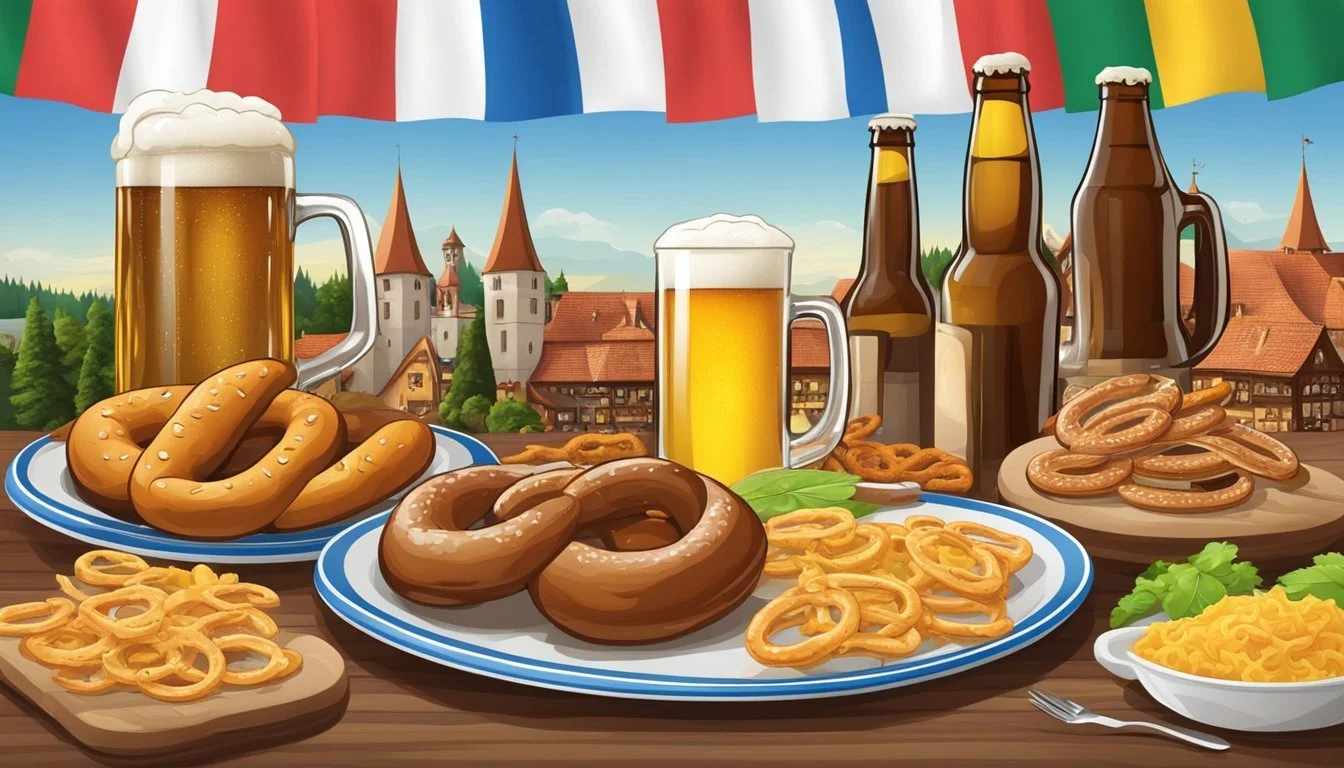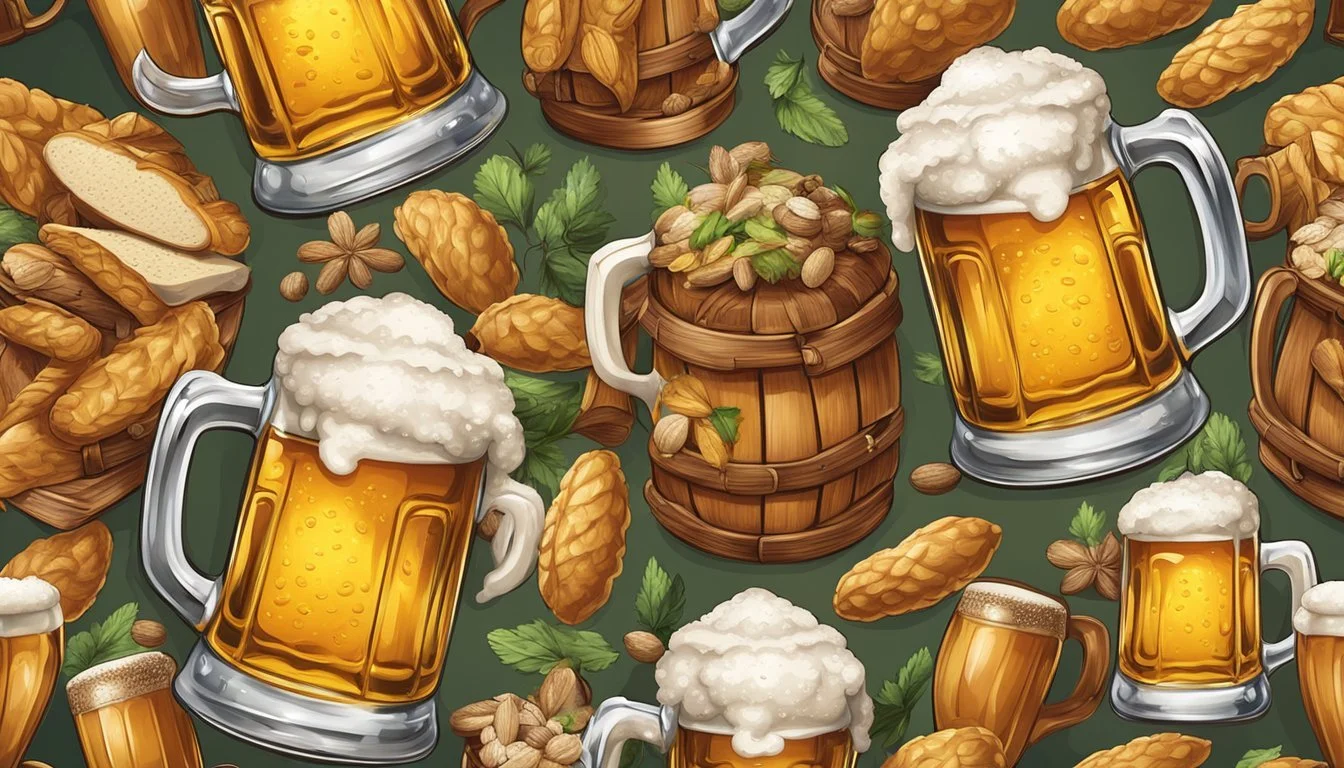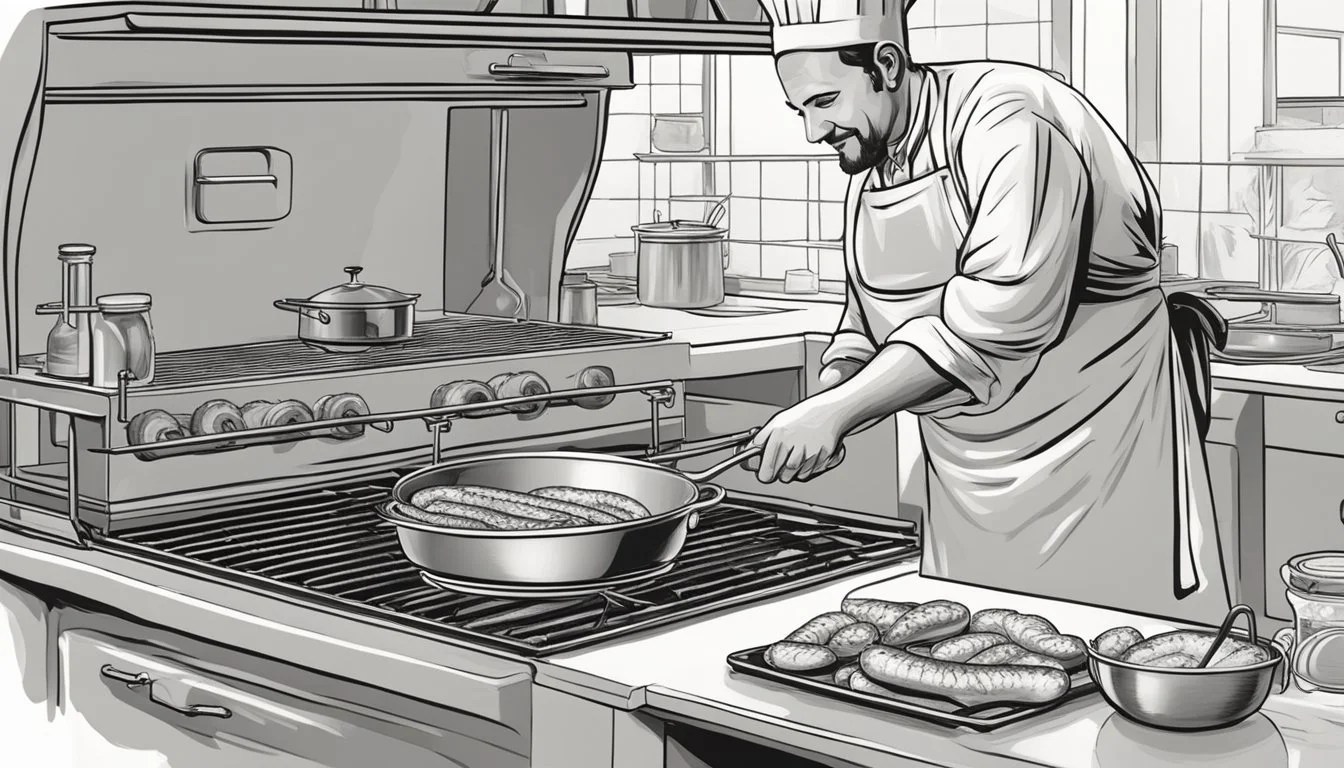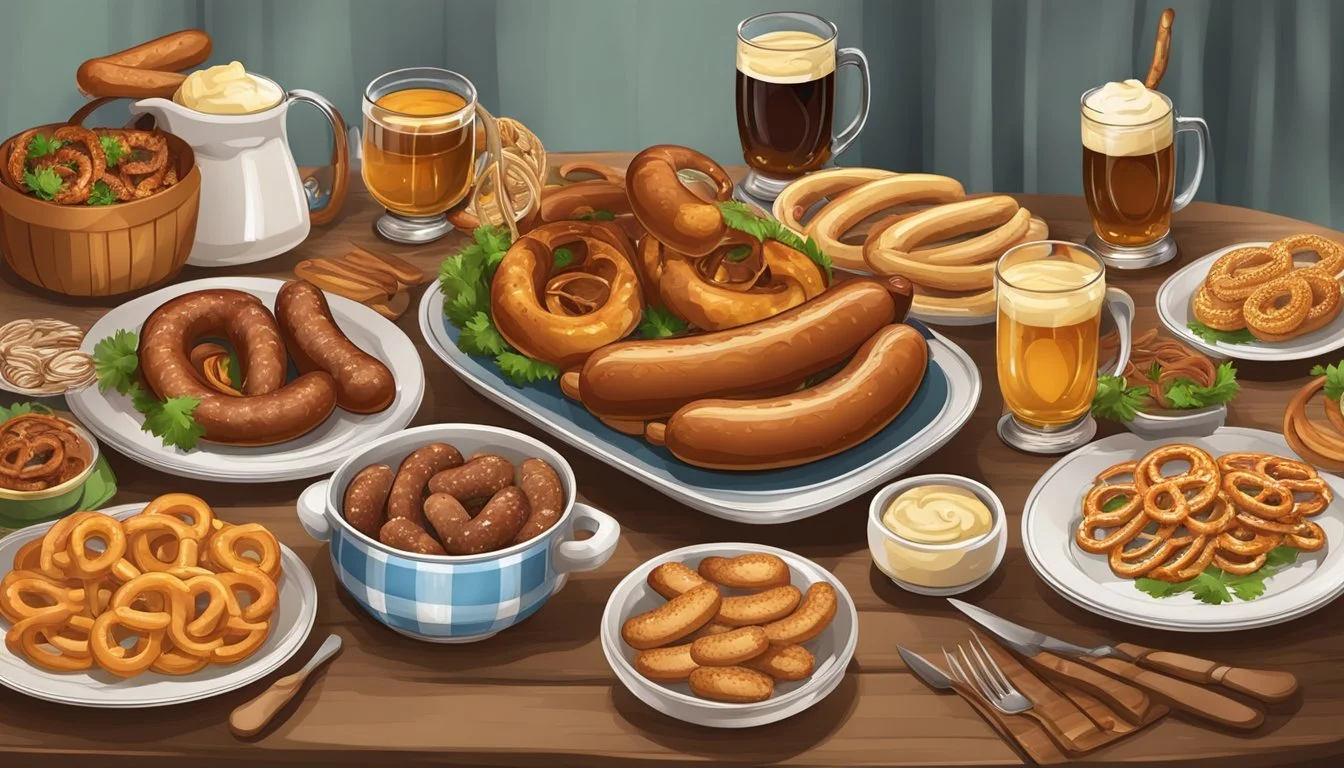German Texan Oktoberfest Food Traditions and Recipes
A Culinary Heritage Guide
German Texan communities have long celebrated their heritage through food, especially during the Oktoberfest season. Oktoberfest is not only an iconic Bavarian festival but has also become a staple event in German Texan culture, marrying traditional German cuisine (What Wine Pairs Perfectly With German Cuisine) with the Lone Star State’s unique culinary flair. The festival is a vibrant testament to the enduring influence of German immigrants who began settling in Texas during the early 19th century. Every Oktoberfest, these communities revive the communal spirit with a bounty of German-inspired dishes that have been passed down through generations.
The festival’s food offerings are a highlight, showcasing an array of traditional Oktoberfest dishes with a Texan twist. Long communal tables are laden with hearty fare like bratwursts simmered in local craft beers, sauerkraut, and pretzels that pair perfectly with the various ales and lagers on tap. Half roast chickens, known as “Brathendl,” are another Oktoberfest staple, spit-roasted to golden perfection. Whereas traditional sides in Bavaria might include potato salad or red cabbage, it's not unusual to see these classics served alongside Texas favorites such as cheesy hash brown casserole, adding a local flavor to the celebration.
These culinary traditions offer a window into the past as much as they serve as a centerpoint for contemporary festivities. Oktoberfest parties in German Texan communities go beyond merely replicating Bavarian customs; they embody a fusion of the immigrant ethos with Texan hospitality. The result is a festive atmosphere where food is both a bridge to a shared German heritage and a celebration of cultural integration in the heart of Texas.
Historical Context
German traditions, particularly the celebration of Oktoberfest, have significantly influenced Texas culture, following a substantial wave of German immigration. The state's culinary landscape notably reflects this heritage during fall festivities.
German Immigration to Texas
In the 1830s, significant numbers of Germans immigrated to Texas, seeking opportunities in Stephen F. Austin's colony through enticing land grants. They left an indelible mark on the culture and traditions, which prominently surface in Texas's culinary celebrations.
Origins of Oktoberfest
Oktoberfest has its roots in Munich, Bavaria, where it initially began as a royal wedding celebration in 1810. It evolved into an annual festival celebrating Bavarian culture, including traditional attire like lederhosen and dirndl. This festival was brought to Texas by German immigrants, and today blends local Texan influences with historic German customs.
Traditional Oktoberfest Foods
Oktoberfest celebrations in German Texan communities are a vibrant display of cultural pride and culinary traditions. Attendees can expect a variety of hearty and traditional dishes, each with a distinct German influence.
Main Dishes
Oktoberfest food is renowned for its robust and flavorful main dishes. Schweinshaxe, a tender and savory roasted pork knuckle, is a Bavarian dish that’s often a centerpiece. Another staple is the Sauerbraten, a pot roast, usually of beef, marinated before cooking as pot roast. Schnitzel, breaded and fried thin cuts of meat, are also commonly served, providing a crispy delight to festival-goers. Sausage lovers look forward to an assortment of wursts, including Bratwurst, which is often simmered in beer and then grilled.
Sides and Salads
Sides are just as important as the main fare in completing the Oktoberfest meal experience. German Potato Salad, typically served warm, is a tangy accompaniment made with potatoes, bacon, vinegar, and mustard. The presence of sauerkraut and rotkohl (red cabbage) provides a punch of flavor and a balance to the richness of the meats. Wurstsalat, a sausage salad prepared with vinegar and onions, is also a popular choice.
Side Dish Main Ingredients Description Potato Salad Potatoes, bacon, vinegar Warm and tangy with a mustard dressing. Sauerkraut Fermented cabbage Tangy and flavorful to balance meats. Rotkohl Red cabbage, vinegar A sweet and sour accented side dish. Wurstsalat Sausage, onions, vinegar Refreshing and sharp, often as salad.
Desserts
Desserts at Oktoberfest are a sweet finale to the rich and hearty meal. The iconic Apple Strudel is a must-try, with its flaky crust and sweet-tart apple filling. Additionally, offerings include Potato Pancakes, usually served with apple sauce, introducing a sweet and savory twist to the palate.
Apple Strudel: Flaky pastry filled with spiced apples.
Potato Pancakes: Grated potatoes fried to a golden brown, often topped with apple sauce.
Tasting these traditional foods offers a glimpse into the German heritage and the culinary legacy that German Texans proudly preserve and celebrate during Oktoberfest.
Oktoberfest Beer and Beverages
In celebrating Oktoberfest, attendees immerse themselves in a rich tapestry of German brewing traditions. The event features a variety of authentic German beers alongside much-loved non-alcoholic beverages, ensuring everyone can partake in the festive atmosphere.
Beer Varieties
Märzen: Traditionally the star of Oktoberfest, this lager, with its rich amber color, boasts a smooth, toasty malt flavor that pairs well with hearty foods. Brewed in March, hence the name, it is stored in cellars to be enjoyed in autumn.
Dunkel: A darker lager beer that offers a malty taste with chocolate and caramel notes. It is a staple for those who enjoy a richer, more robust beer.
Schwarzbier: Literally means "black beer" in German, this variety is known for its dark color and surprisingly light taste, offering subtle hints of chocolate and coffee without the heavy body of a stout.
Golden Lager: A lighter beer that features a balance of hops and malt. It's a crisp beverage suitable for those preferring subtler flavors.
Weissbier/Dunkelweiss: These wheat beers are characterized by a cloudy appearance and can come in lighter (Weissbier) or darker (Dunkelweiss) varieties, with refreshing banana and clove flavors from the yeast.
Non-Alcoholic Options
Radler: For those seeking a lower-alcohol or non-alcoholic choice, the Radler is a popular option. It is a mix of lemonade and either sparkling water or a light beer, creating a refreshing and thirst-quenching beverage ideal for warm Oktoberfest afternoons.
Soft Drinks and Juices: Fest-goers can also enjoy a variety of soft drinks, including classic sodas and fruit juices, which are widely available and provide a sweet respite for all ages.
Mineral Water: A staple at any German gathering, mineral water, both still and sparkling, offers a pure and hydrating option for those who prefer to abstain from alcohol but still wish to toast to good health and good times.
German Texan Fusion Cuisine
The German Texan fusion cuisine embodies a seamless blend of Central European flavors with Texas-style cooking, creating distinctive dishes that celebrate both heritages. This culinary synthesis manifests through innovative recipes and the significant impact it has on regional barbecue (What wine goes well with barbecue?) practices.
Modern Adaptations
In the sphere of German Texan fusion food, certain dishes have emerged as stellar representations of this culinary marriage. The Bavarian Apple-Sausage Hash is one such innovation that showcases the union of classic German flavors with Texan bravado. Here, hearty potatoes and succulent sausages are intermingled with the sweetness of apples, commonly found in Bavarian recipes, to create a comforting, skillet-cooked meal often enjoyed at Oktoberfest celebrations in Texas.
Another dish that stands out is the Oktoberfest Casserole, which layers sauerkraut, a German staple, between strips of Texan smoked meat. The ensemble is then topped with buttery breadcrumbs, a nod to the European palate, making it an indulgent, crowd-pleasing entrée.
Influences on Texas BBQ
German settlers heavily influenced Texas BBQ, particularly in the preparation and variety of meats. They introduced techniques of smoking and seasoning that are now fundamental in Texan barbecue culture. For instance, the inclusion of beef links, a nod to the German sausage-making tradition, remains prevalent in Texas barbecue joints. They offer a wide range of sausages, from mildly seasoned to those packed with robust spices, paralleling the diversity found in German wurst.
Moreover, sauces and condiments show a notable German influence, with German Beer Cheese Dip standing as a prime example. Adapted to feature local Texan beers and cheeses, this dip complements the smoky flavors of barbecued meats (What wine goes well with barbecued meats?) and is frequently served alongside pretzels or other sides at festive gatherings.
Oktoberfest Cooking Techniques
The culinary traditions of German-Texan Oktoberfest are celebrated with specific cooking techniques that bring out the rich flavors of traditional meats and dishes. These methods have been honed over generations and are essential for creating authentic Oktoberfest fare.
Traditional Cooking Methods
Roasting is central in preparing Oktoberfest Brathendl, better known as roast chicken. Chefs typically roast whole chickens on a spit, ensuring the skin becomes crispy while keeping the inside tender and juicy.
Braising is another popular technique, often used for making Sauerbraten, a marinated roast beef stew (What wine goes well with beef stew?) served with a savory gravy. The meat is seared at high temperatures and then slow-cooked in a seasoned broth, yielding a flavorful and tender dish.
Simmering plays a vital role in creating German beer brats, where bratwurst sausages are slowly cooked in a flavorful beer and onion sauce, infusing them with a distinctive malty taste.
Grilling and Smoking
Grilling is ideal for preparing German pork schnitzel, where thin cuts of pork are breaded and fried until golden. A variant of this is seen in the grilled fish, typically trout or mackerel, seasoned simply with salt and sometimes stuffed with herbs before grilling to perfection.
Smoking imparts a deep, woodsy flavor to meats like bacon and ham. During Oktoberfest, these smoked meats (What wine goes well with smoked meats?) feature prominently alongside freshly baked pretzels, adding a robust taste and aroma that are signature to the festival's offerings.
Oktoberfest Recipe Collection
The fusion of German and Texan culinary traditions during Oktoberfest brings about an array of distinctive recipes. These dishes celebrate the German heritage with a Texan twist, emphasizing both authentic flavors and local adaptations.
Appetizers
Obatzda: A rich, flavorful cheese spread, Obatzda is a quintessential Bavarian appetizer. It combines Camembert or Brie cheese with butter, beer, and spices like caraway seeds for a robust start to any Oktoberfest feast.
German Soft Pretzels: This staple pairs perfectly with Obatzda, featuring a soft, warm center and a light, crispy crust sprinkled with coarse salt.
Beer-Inspired Dishes
Beer Brats: Bratwurst sausages simmered in a flavorful malty beer and onion sauce.
Oktoberfest Casserole: This dish blends the hearty elements of a cheesy hash brown casserole with the savory flavors of bratwurst and sauerkraut.
Sweet Treats
Apfelstrudel (Apple Strudel): Thin layers of dough filled with tart apples, raisins, and cinnamon, often served with a dollop of vanilla sauce or Bavarian cream.
Gebrannte Mandeln (Candied Almonds): These sweet and crunchy almonds are a favorite at any festival and are simple to make with just a few ingredients.
The table below summarizes some key ingredients for the recipes mentioned:
Recipe Key Ingredients Obatzda Cheese, Butter, Beer, Spices German Soft Pretzels Flour, Yeast, Pretzel Salt Beer Brats Bratwurst, Beer, Onions Oktoberfest Casserole Hash Browns, Bratwurst, Sauerkraut Apfelstrudel Apples, Raisins, Cinnamon, Dough Gebrannte Mandeln Almonds, Sugar, Cinnamon
These recipes embody the festive and communal spirit of Oktoberfest, offering a taste of German-Texan hospitality that's hard to resist.
Oktoberfest Party Planning
When one hosts an Oktoberfest party, they should pay particular attention to creating a festive atmosphere with authentic German-Texan touches and encouraging guests to dress in traditional attire. Both elements set the stage for an immersive experience.
Decor and Ambiance
A host should begin by transforming their space into a Bavarian festhall. Tables draped with blue and white checkered tablecloths not only represent the Bavarian flag but also invite a communal dining experience. Centerpieces featuring autumnal elements like wheat, hops, and mustard flowers can add a rustic touch. Providing ample bench-style seating encourages the communal spirit of Oktoberfest.
For lighting, string lights in white or soft yellow can mimic the warm glow of a beer garden. Thematic decor such as beer steins, pretzel garlands, and Oktoberfest banners contribute to the German-Texan flair. Traditional Volksmusik or polka tunes can be played in the background to enrich the party's ambiance.
Costumes and Attire
Encouraging guests to dress in traditional costumes enhances the authenticity of an Oktoberfest celebration. Men can don lederhosen, which are knee-length leather breeches, often accompanied by checkered shirts, Alpine hats, and woolen knee socks. Women can wear dirndls, which consist of a bodice, blouse, full skirt, and apron, celebrating their German heritage or affinity for the culture.
Participants may choose to don attire that reflects their Texan background, integrating cowboy boots or hats with their German costumes, thereby fusing two rich cultures. This nod to their Texan roots mixed with traditional German garments showcases the unique blend that defines German-Texan Oktoberfest celebrations.








